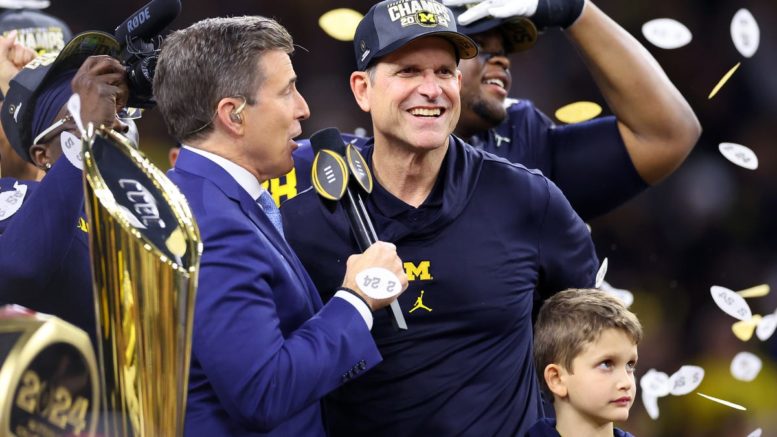As maize-and-blue confetti streamed from the NRG Stadium rafters, it felt like the Big Ten’s harvest was finally ripening. The national title game was decided when Michigan outmuscled Alabama a week earlier, but Monday night’s national title was merely the coup de grâce in a process that began five months ago after the Big Ten poached UDub, along with Oregon, USC and UCLA because the Pac-12 failed to procure a media deal to replace their expiring contract with ESPN that would put their schools on equal financial footing to the Big Ten or SEC. Whether Jim Harbaugh stays in Ann Arbor or returns to the NFL, the Big Ten has changed since 2015.
For the past two decades, the Big Ten has been derided as a slower, less explosive, Middle America version of college football than the superior version played in the SEC. It’s not completely their fault. Snow precipitation and the paucity of recruiting hotbeds put Big Ten schools at a disadvantage. At the start of this decade, the SEC gained momentum by agreeing to a 10-year, $3 billion television deal with ESPN, poached the Big 12’s most profitable programs and produced a new dynasty to challenge Alabama in Athens, Georgia. The Big Ten appeared destined to remain the SEC’s vassal for another realignment cycle.
This summer, the Big Ten began its most dramatic growth spurt. During the 2021-22 fiscal year the Big Ten distributed $845.6 million total and $58.8 million per conference school, according to USA Today. The SEC shelled out $802 million total, $49.9 million to each program, while the Pac-12 paid $37 million. The Big Ten’s payout to their member schools is expected to double next season when their seven-year, $8 billion CBS deal kicks in. That financial disparity activated the Pac-12’s kill switch and the Big Ten pounced. Over the years, Harbaugh has needled the NCAA about providing the players with a share of college football’s massive revenues. That rubicon is approaching and when it does, the Big Ten will be in an even stronger position.
On the gridiron, the SEC had won 13 of the last 17 national titles before this season. Fourteen out of 18 is still impressive, but it’s the future that should have college football’s former flyover conference upbeat. As the cherry on top, the Big Ten decided to spare the nation from its Big Ten West slate by abolishing its lopsided divisions. Matching resources is half the battle. Recruiting outside of the Big Ten is crucial.
Urban Meyer imported SEC speed to the Big Ten. Once that transition began, Michigan had to match. Rich Rodriguez went to the extremes sacrificing physicality for sonic speed and quickness. Brady Hoke went too far in the other direction and then Harbaugh found equilibrium. The Big Ten’s lack of recruiting hotbeds and cold weather has always put them at a disadvantage, but as spread offenses become more ubiquitous, the trend appears to be moving back in the favor of teams that are a blend.
The age of the Big Ten could be upon us, but there’s work left to be done. They can teach the Pac-12’s refugees about the core tenets of a rugged defense and the Pac-12 can build a quarterback pipeline that didn’t exist before. Even at the height of its success, LSU plucked the top signal caller in the Class of 2025 right out of Bellevue, Mich. There’s still time to flip Bryce Underwood, but it speaks to the Big Ten quandary.
The four erstwhile Pac-12 schools hail from regions that have produced 15 first-round quarterbacks since 2002. Caleb Williams is projected to go No. 1 overall, then Michael Penix and Bo Nix could sneak into the first behind him. 2024 alone could eclipse the number of first-round quarterbacks taken out of the Big Ten in the last 30 years. Until 2015 when Washington selected Dwayne Haskins No. 15, no Big Ten quarterback had been taken in the first round of the draft since Kerry Collins in 1995. In 2023, CJ Stroud became the third.
The last time the Big Ten went chasing large markets, they watered down their league with Rutgers and Maryland. Oregon, Washington, USC and UCLA however, bring depth, established brands, robust media markets and buzz to the Big Ten. More importantly, it’s about to become more than just a two-team conference. Rust Belt population growth has only fertilized the SEC’s recruiting soil, but Big Ten imperialism and Harbaugh’s satellite camps know no bounds.
Follow DJ Dunson on X: @cerebralsportex
Original source here
#Michigans #national #title #crop #Big #Tens #budding #football #harvest





